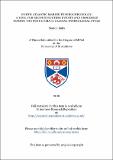Files in this item
North Atlantic marine tephrochronology : a tool for reconstructing events and processes during the penultimate glacial-interglacial cycle
Item metadata
| dc.contributor.advisor | Roucoux, Katherine | |
| dc.contributor.advisor | Austin, W. E. N. (William E. N.) | |
| dc.contributor.author | Kuhs, Marion | |
| dc.coverage.spatial | 146 p. | en_US |
| dc.date.accessioned | 2020-03-04T11:29:38Z | |
| dc.date.available | 2020-03-04T11:29:38Z | |
| dc.date.issued | 2016-11-30 | |
| dc.identifier.uri | https://hdl.handle.net/10023/19595 | |
| dc.description | Electronic version excludes material for which permission has not been granted by the rights holder | en |
| dc.description.abstract | The focus of this thesis is the analyses of tephra deposits found in the penultimate glacial–interglacial interval of the marine sediments from Integrated Ocean Drilling Project (IODP) Site U1304, southern Gardar Drift, North Atlantic. The location and the high-resolution of U1304 are ideal to investigate changes in deep-ocean ventilation, sea-surface circulation pattern well as ice-sheet dynamics. Especially, the climate conditions during the Last Interglacial (LIG) with warmer annual temperature and higher global sea-level are of particular interest because this period is often seen as an analogue to predicted future climate scenarios. By means of geochemical and shard size analyses the transport mechanism of the tephra deposits were determined. The tephra deposits found during the penultimate glacial (Marine Isotope Stage 6 (MIS 6)) were transported by iceberg–rafting. Comparison of individual shard geochemistry with the geochemistry of Holocene volcanic systems from Iceland showed that the shards originated from different volcanic systems on Iceland. Combining source evidence with Icelandic Ice Sheet (IIS) flow models for the Last Glacial Maximum (LGM) suggests that the IIS had marine calving margins to both the north and south of Iceland during the late MIS 6 and that icebergs could have been transported to the U1304 core site by following surface ocean circulation patterns similar to those that prevailed during the LGM. In contrast, one of the analysed tephra horizons deposited during MIS 5e at the U1304 core site can be correlated with the known 5e-Eem/RHY-I isochron in the tephrostratigraphical framework of the North Atlantic. The 5e-Eem/RHY-I tephra is also found in the nearby marine sediment core MD99-2253. In both cores, U1304 and MD99-2253, the 5e-Eem/RHY-I tephra occurs just above the onset of fully-interglacial deep-ocean ventilation, indicated by an abrupt shift in foraminiferal benthic δ¹³C. Aligning both cores on a common timescale with the 5e-Eem/RHY-I age of 121.99 ± 1 ka as an additional tie-point, suggests that the onset to full-interglacial conditions occurred synchronously at both core sites. This finding provides the opportunity to develop a new event-based stratigraphy, reliably sub-dividing MIS 5e into an early and later phase. | en_US |
| dc.language.iso | en | en_US |
| dc.publisher | University of St Andrews | |
| dc.relation | Kuhs, M. et al., 2014. Iceberg-rafted tephra as a potential tool for the reconstruction of ice-sheet processes and ocean surface circulation in the glacial North Atlantic. Geological Society, London, Special Publications, 398(1), pp.141–155. DOI: https://doi.org/10.1144/SP398.8 | en_US |
| dc.relation.uri | https://doi.org/10.1144/SP398.8 | |
| dc.subject | Tephrochronology | en_US |
| dc.subject | 5e-Eem/RHY-I | en_US |
| dc.subject | Delayed fully-interglacial | en_US |
| dc.subject | MIS 5e | en_US |
| dc.subject | MIS 6 | en_US |
| dc.subject | Icelandic ice sheet | en_US |
| dc.subject | Ocean surface circulation | en_US |
| dc.subject | Deep-ocean ventilation | en_US |
| dc.title | North Atlantic marine tephrochronology : a tool for reconstructing events and processes during the penultimate glacial-interglacial cycle | en_US |
| dc.type | Thesis | en_US |
| dc.contributor.sponsor | Natural Environment Research Council (NERC) | en_US |
| dc.type.qualificationlevel | Masters | en_US |
| dc.type.qualificationname | MPhil Master of Philosophy | en_US |
| dc.publisher.institution | The University of St Andrews | en_US |
This item appears in the following Collection(s)
Items in the St Andrews Research Repository are protected by copyright, with all rights reserved, unless otherwise indicated.

